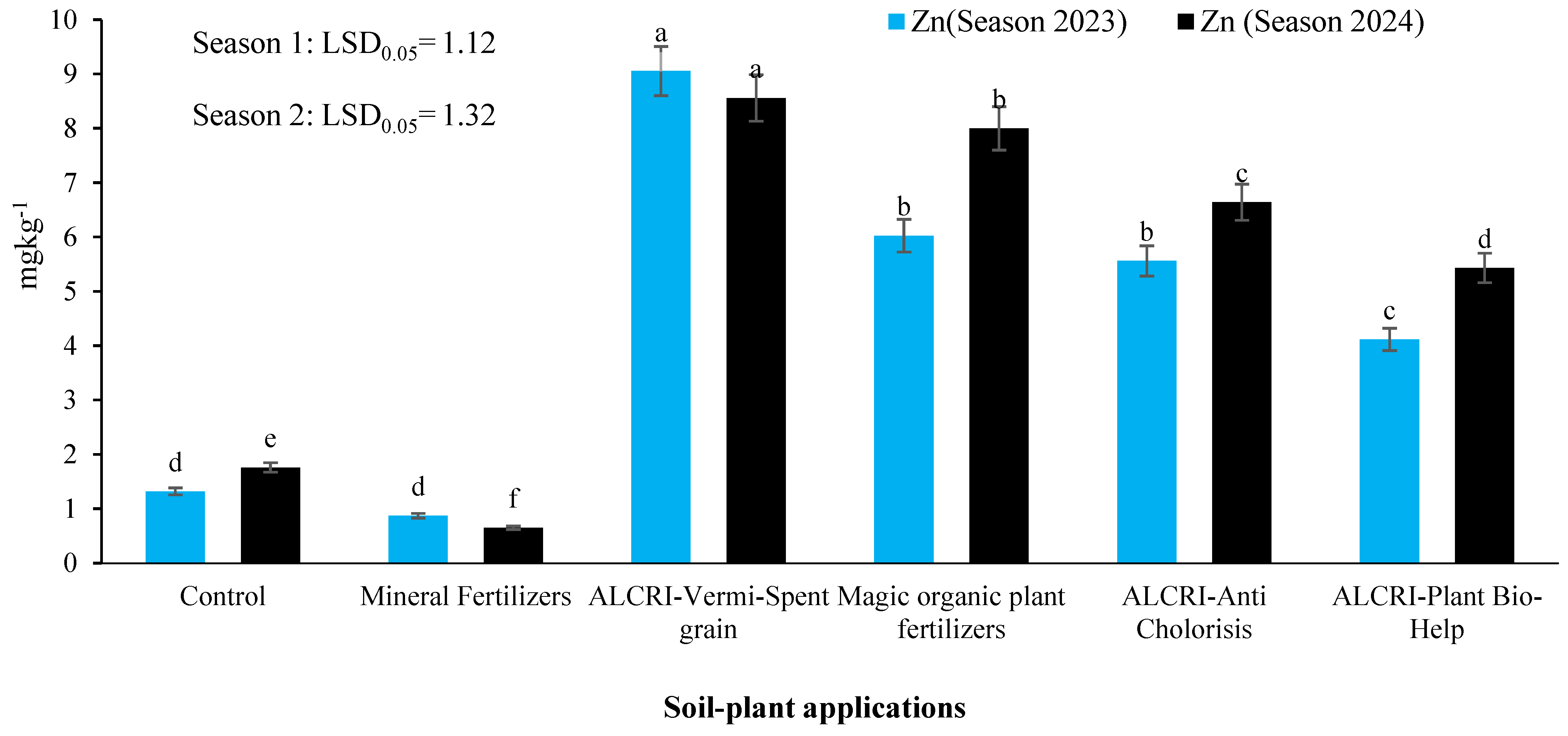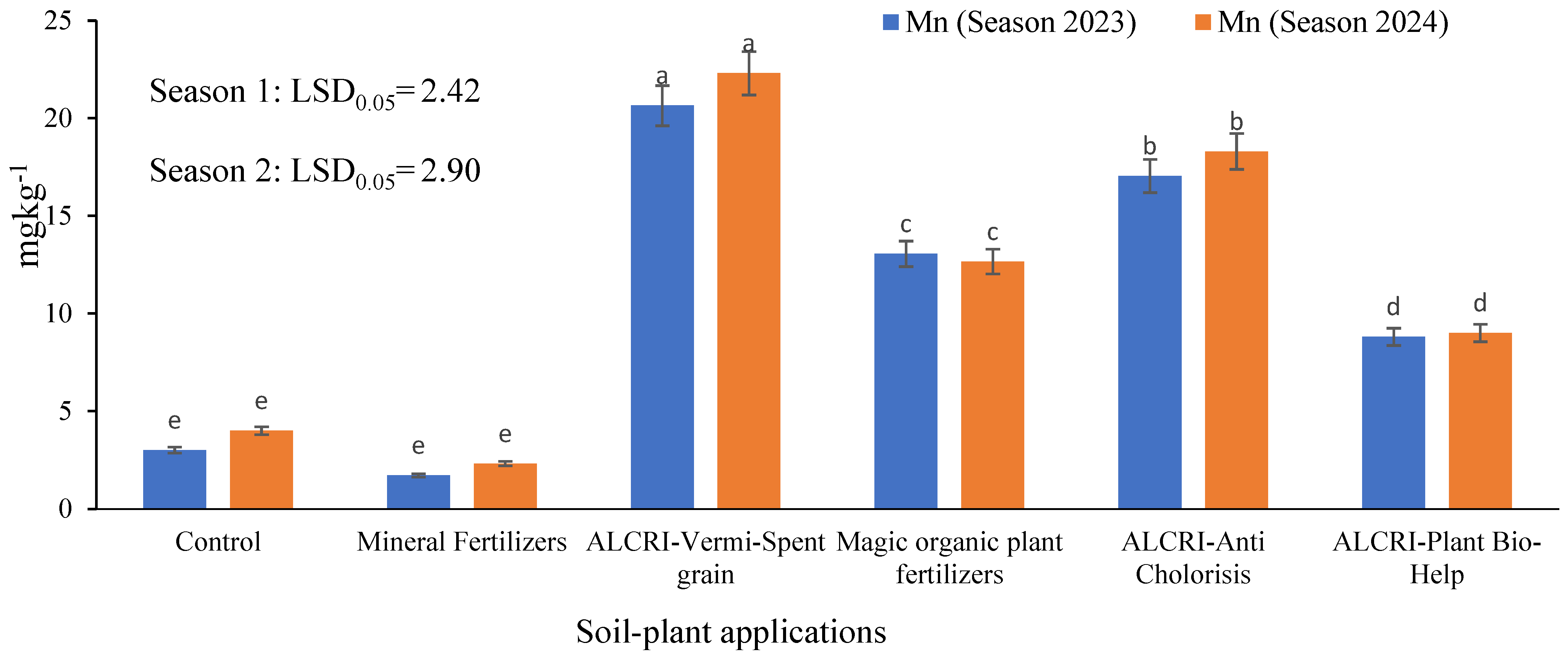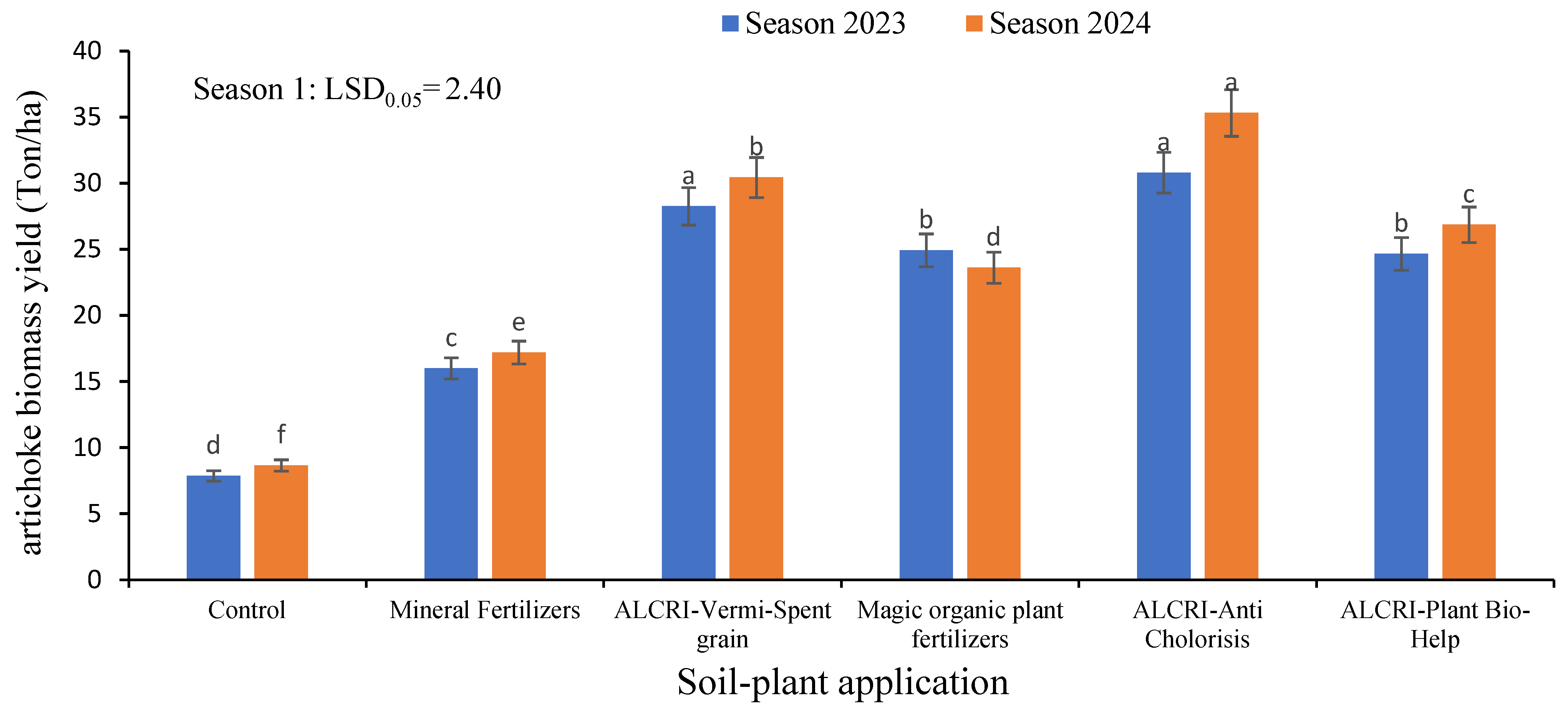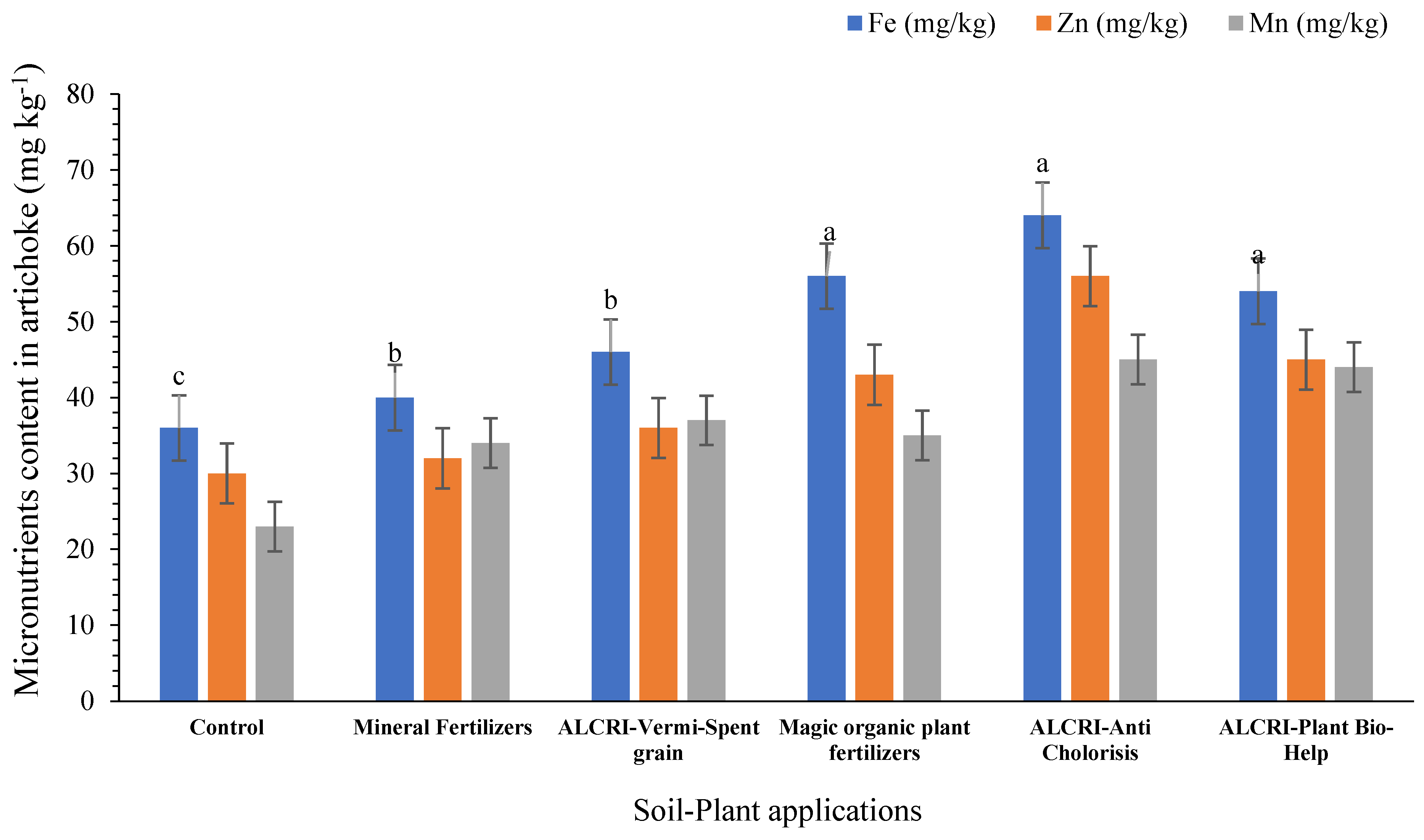Enhancing Micronutrient Availability Through Humic Substances and Vermicompost While Growing Artichoke Plants in Calcareous Soil: Insights from a Two-Year Field Study
Abstract
1. Introduction
2. Results
2.1. Iron Content of the Soil
2.2. Zinc (Zn) Content of the Soil
2.3. Manganese Content of the Soil
2.4. Copper Content of the Soil
2.5. Scanning Electron Microscopic (SEM) Observations
2.6. Biomass of Artichoke Yield Indicator in Calcareous Soil
2.7. Effect of the Micronutrients Content on Artichoke Fruit
3. Discussion
4. Materials and Methods
4.1. Study Site Information
4.2. Experimental Layout
4.3. Preparation of Vermicompost (ALCRI-Vermicompost)
4.4. Preparation of the Humic Substances (Magic Plant Fertilizer)
4.5. Preparation of the Microelements Solution (ALCRI-Anti Chlorosis)
4.6. Soil Analyses
4.7. Plant Analyses
4.8. SEM Examination
4.9. Statistical Analysis
5. Conclusions
Author Contributions
Funding
Data Availability Statement
Acknowledgments
Conflicts of Interest
References
- Abd El-Haleem, A.A. Iron availability as affected by CaCO3 Particle size and Fe: P ratio in Fe-P-containing compounds. Egypt J. Appl. Sci. 1996, 11, 308–327. [Google Scholar]
- FAO-UNESCO. Soil Classification. Food and Agriculture Organization of the United Nations. 2018. Available online: https://www.fao.org/soils-portal/data-hub/soil%20classification/en/ (accessed on 1 January 2020).
- Hafez, M.; Abdulla, A.M.; Mohamed, A.E.; Rasha, M. Influence of environmental-friendly bio-organic ameliorants on abiotic stress to sustainable agriculture in arid regions: A long term greenhouse study in northwestern Egypt. J. King Saud Univ. Sci. 2022, 34, 102212. [Google Scholar] [CrossRef]
- Hafez, M.; Popov, A.I.; Rashad, M. A Novel Environmental Additives to Decrease Nitrate Level in Agriculture Wastewater and Enhancement Nutrient Status Under Greenhouse Plant Growth in Calcareous Soil. Plant Arch. 2020, 20, 3165–3172. [Google Scholar]
- Hafez, M.; Popov, A.I.; Rashad, M. Enhancing calcareous and saline soils fertility by. increasing organic matter decomposition and enzyme activities: An incubation study. Commun. Soil Sci. Plant Anal. 2022, 53, 2447–2459. [Google Scholar] [CrossRef]
- Zhang, L.; Wang, L.; Li, F.; Xiao, F.; Yu, H. Effect of divalent manganese (Mn2+) concentration on the growth and nitrate nitrogen content of lettuce during aeroponic intercropping with cherry radish. Hortic. Environ. Biotechnol. 2021, 62, 243–251. [Google Scholar] [CrossRef]
- Roy, C.; Kumar, S.; Ranjan, R.D.; Kumhar, S.R.; Govindan, V. Genomic approaches for improving grain zinc and iron content in wheat. Front. Genet. 2022, 13, 1045955. [Google Scholar] [CrossRef]
- Cheng, C.; Han, H.; Wang, Y.P.; Wang, R.; He, L.Y.; Sheng, X.F. Biochar and metalimmobilizing Serratia liquefaciens CL−1 synergistically reduced metal accumulation in wheat grains in a metal-contaminated soil. Sci. Total Environ. 2020, 740, 139972–139980. [Google Scholar] [CrossRef]
- Ryan, M.H.; McInerney, J.K.; Record, I.R.; Angus, J.F. Zinc bioavailability in wheat grain in relation to phosphorus fertiliser, crop sequence and mycorrhizal fungi. J. Sci. Food Agric. 2008, 88, 1208–1216. [Google Scholar]
- Turmel, M.S.; Entz, M.H.; Bamford, K.C.; Thiessen Martens, J.R. The influence of crop rotation on the mineral nutrient content of organic vs. conventionally produced wheat grain: Preliminary results from a long-term field study. Can. J. Plant Sci. 2009, 89, 915–919. [Google Scholar]
- Smith-Spangler, C.; Brandeau, M.L.; Hunter, G.E.; Bavinger, J.C.; Pearson, M.B.; Eschbach, P.J.; Sundaram, V.; Liu, H.; Schirmer, P.; Stave, C.; et al. Are organic foods safer or healthier than conventional alternatives? A systematic review. Ann. Intern. Med. 2012, 157, 348–366. [Google Scholar]
- Ferhi, J.; Gharsalli, M.; Abdelli, C.; Krouma, A. Potential of the physiological response of Pea plants (Pisum sativum L.) to iron deficiency (direct or limeinduced). Biosci. J. 2017, 33, 1208–1218. [Google Scholar]
- Teklu, D.; Gashu, D.; Joy, E.J.M.; Lark, R.M.; Bailey, E.H.; Wilson, L.; Amede, T.; Broadley, M.R. Genotypic Response of Finger Millet to Zinc and Iron Agronomic Biofortification, Location and Slope Position towards Yield. Agronomy 2023, 13, 1452. [Google Scholar] [CrossRef]
- Azam, M.; Bhatti, H.N.; Khan, A.; Zafar, L.; Iqbal, M. Zinc oxide nano-fertilizer application (foliar and soil) effect on the growth, photosynthetic pigments and antioxidant system of maize cultivar. Biocatal. Agric. Biotechnol. 2022, 42, 102343. [Google Scholar]
- Rashad, Y.M.; Abbas, M.A.; Soliman, H.M.; Abdel-Fattah, G.G.; Abdel-Fattah, G.A. Synergy between endophytic Bacillus amyloliquefaciens GGA and arbuscular mycorrhizal fungi induces plant defense responses against white rot of garlic and improves host plant growth. Phytopathol. Mediterr. 2020, 59, 169–186. [Google Scholar]
- Jones, D.L.; Healey, J.R. Use of organic amendments for remediation: Turning waste to good use. Elements 2010, 6, 369–374. [Google Scholar] [CrossRef]
- Rashad, Y.M.; Hafez, M.; Rashad, M. Diazotrophic Azotobacter salinestris YRNF3: A probable calcite-solubilizing bio-agent for improving the calcareous soil properties. Sci. Rep. 2023, 13, 20621. [Google Scholar]
- Wang, Y.; Xu, Y.; Liang, X.; Wang, L.; Sun, Y.; Huang, Q.; Zhao, L. Soil application of manganese sulfate could reduce wheat Cd accumulation in Cd contaminated soil by the modulation of the key tissues and ionomic of wheat. Sci. Total Environ. 2021, 770, 145328–145339. [Google Scholar]
- Zaynab, M.; Fatima, M.; Abbas, S.; Sharif, Y.; Umair, M.; Zafar, M.H.; Bahadar, K. Role of secondary metabolites in plant defense against pathogens. Microb. Pathog. 2018, 124, 198–202. [Google Scholar]
- Hou, J.; Gao, X.; Entz, M.H. Enhancing zinc and iron bioavailability through crop rotation and organic farming: Insights from a long-term study. Field Crops Res. 2025, 322, 109710. [Google Scholar]
- Hale, L.; Curtis, D.; Azeem, M.; Montgomery, J.; Crowley, D.E.; McGiffen, M.E. Influence of compost and biochar on soil biological properties under turfgrass supplied deficit irrigation. Appl. Soil Ecol. 2021, 168, 104134. [Google Scholar] [CrossRef]
- Hafez, M.; Popov, A.I.; Rashad, M. Influence of Agro-industrial Wastes and Azospirillum on Nutrients Status and Grain Yield under Corn Plant Growth in Arid Regions. Biosci. Res. 2019, 16, 2119–2130. [Google Scholar]
- Hafez, M.; Rashad, M.; Popov, A.I. The biological correction of agro-photosynthesis of soil plant productivity. J. Plant Nutr. 2020, 43, 2929–2980. [Google Scholar] [CrossRef]
- Trevisan, S.; Francioso, O.; Quaggiotti, S.; Nardi, S. Humic substances biological activity at the plant-soil interface: From environmental aspects to molecular factors. Plant Signal Behav. 2010, 5, 635–643. [Google Scholar] [PubMed]
- Kulikova, N.A.; Perminova, I.V. Interactions between Humic Substances and Microorganisms and Their Implications for Nature-like Bioremediation Technologies. Molecules 2021, 26, 2706. [Google Scholar] [CrossRef]
- Tang, Y.; Qin, D.; Tian, Z. Diurnal switches in diazotrophic lifestyle increase nitrogen contribution to cereals. Nat. Commun. 2023, 14, 7516. [Google Scholar] [CrossRef]
- Naqqash, T.; Malik, K.A.; Imran, A.; Hameed, S.; Shahid, M.; Hanif, M.K.; Majeed, A.; Iqbal, M.J.; Qaisrani, M.M.; van Elsas, J.D. Inoculation with Azospirillum spp. acts as the liming source for improving growth and nitrogen use efficiency of potato. Front. Plant Sci. 2022, 13, 929114. [Google Scholar]
- Asiloglu, R.; Shiroishi, K.; Suzuki, K.; Turgay, O.C.; Murase, J.; Harada, N. Protist-enhanced survival of a plant growth promoting rhizobacteria, Azospirillum sp. B510, and the growth of rice (Oryza sativa L.) plants. Appl. Soil Ecol. 2020, 154, 103599. [Google Scholar] [CrossRef]
- Li, M.; Watanabe, S.; Gao, F.; Dubos, C. Iron Nutrition in Plants: Towards a New Paradigm? Plants 2023, 12, 384. [Google Scholar] [CrossRef]
- Bin, L.M.; Weng, L.; Bugter, M.H.J. Effectiveness of FeEDDHA, FeEDDHMA, and FeHBED in preventing iron-deficiency chlorosis in soybean. J. Agric. Food Chem. 2016, 64, 8273–8281. [Google Scholar]
- Ali Suhail, T.; Al-Dulaimi; Al-Rawi, W.A.A. Effects of biofertilizers and compost application on leaves mineral content of plum transplants. Plant Arch. 2020, 20, 1949–1952. [Google Scholar] [CrossRef]
- ALmamori, H.A.; Abdul-ratha, H. Effect of Addition of Vermicompost, Bio and Mineral Fertilizer on the Availability of Some Nutrients in Soil and Potato Yield. Iraqi J. Agric. Sci. 2020, 51, 644–656. [Google Scholar]
- Nanchez-Navarro, A.S.; Ranchez-Romero, J.A.S.; Salas-Sanjuan, M.C.; Bernardeau, M.A.B.; Delga-do-Iniesta, M.J. Medium-term influence of organic fertilization on the quality and yield of a celery crop. Agronomy 2020, 10, 1418. [Google Scholar] [CrossRef]
- Carricondo-Martínez, I.; Berti, F.; Salas-Sanjuan, M.d.C. Different organic fertilisation systems modify tomato quality: An opportunity for circular fertilisation in intensive horticulture. Agronomy 2022, 12, 174. [Google Scholar] [CrossRef]
- Aciksoz, B.S.; Yazicici, A.; Ozturk, L.; Cakmak, I. Biofortification of wheat with iron through soil and foliar application of nitrogen and iron fertilizers. Plant Soil. 2011, 349, 215–225. [Google Scholar] [CrossRef]
- Nadim, M.A.; Awan, I.U.; Baloch, M.S.; Khan, E.A.; Naveed, K.; Khan, M.A. Response of wheat (Triticum aestivum L.) to different micronutrients and their application methods. J. Anim. Plant Sci. 2012, 22, 113–119. [Google Scholar]
- Guo, Z.Q. Soil texture is an important factor determining how microplastics affect soil hydraulic characteristics. Environ. Int. 2022, 165, 107293. [Google Scholar] [PubMed]
- Tran, B.T.T.; Cavagnaro, T.R.; Able, J.A.; Watts-Williams, S.J. Bioavailability of zinc and iron in durum wheat: A trade-off between grain weight and nutrition? Plants. People Planet 2020, 2, 473–486. [Google Scholar]
- Soltanpour, P.N.; Schwab, A.P. A new soil test for simultaneous extraction of macro- and micro-nutrients in alkaline soils. Commun. Soil Sci. Plant Anal. 1977, 3, 195–207. [Google Scholar]
- Jackson, M.L. Soil Chemical Analysis; Constable and Co., Ltd.: London, UK, 1962. [Google Scholar]
- AOAC. Official Methods of Analysis of the Association of Official’s Analytical Chemists, 7th ed.; Association of Official Analytical Chemists: Arlington, VA, USA, 2003. [Google Scholar]
- Negm, A.M.; Abu-hashim, M. Sustainability of Agricultural Environment in Egypt: Part II. In The Handbook of Environmental Chemistry; Negm, A.M., Abu-hashim, M., Eds.; Springer International Publishing: Cham, Switzerland, 2019; Volume 3, pp. 317–347. [Google Scholar]
- Estefan, G.; Sommer, R.; Ryan, J. Methods of Soil, Plant, and Water Analysis: A Manual for the West Asia and North; International Center for Agricultural Research in the Dry Areas (ICARDA): Beirut, Lebanon, 2013. [Google Scholar]
- Jones, J.R.J.; Case, V.W. Sampling, Handling, and Analyzing Plant Tissue Samples; Westerman, R.L., Ed.; Soil Testing and Plant Analysis; Soil Science Society of America: Madison, WI, USA, 1990; pp. 389–428. [Google Scholar]







| Treatment | Description | Application Dose, Time and Concentration |
|---|---|---|
| Control | Untreated soil and plant | |
| Mineral fertilizer | Soil amendments | * 300 kg ha−1 of N, P, and K (20:20:20) was applied once as a soil treatment before planting |
| Magic plant fertilizer (humic substances solution) | Seed treatments and soil | 5 L 50 kg−1 of seeds was added twice with seed sowing in the greenhouse and plant growth in the soil |
| ALCRI-anti chlorosis (trace elements solution) | Foliar and soil applications | 4.76 L ha−1 was added three times during the plants’ growth |
| ALCRI-vermi-spent grain (vermicompost) | Applied as a soil treatment | 3.57-ton ha−1 was added once during the seed sowing |
| ALCRI-bio-help (humic substances with Azotobacter sp.) | Seeds and soil treatments | 5 L 50 kg−1 of seeds and 10 L/ha added to the soil three times with water irrigation |
| Treatments | pH | EC | TN | OM | TOC | Ca | Mg | Fe | Zn | Mn |
|---|---|---|---|---|---|---|---|---|---|---|
| mS cm−1 | g kg−1 | mg kg−1 | ||||||||
| ALCRI-Vermicompost | 7.5 | 1.2 | 25 | 350 | 200 | 20 | 5 | 100 | 50 | 40 |
| Magic Plant Fertilizer | 7.0 | 0.8 | 10 | 300 | 150 | 15 | 3 | 80 | 30 | 20 |
| ALCRI-Anti Chlorosis | 6.0 | 0.5 | 1.0 | 0.00 | 0.00 | 1.0 | 0.5 | 160 | 40 | 30 |
| ALCRI-Bio-Help | 6.5 | 0.6 | 15 | 320 | 180 | 18 | 4 | 90 | 35 | 25 |
| Treatment | N | P | K | Fe | Zn | Mn |
|---|---|---|---|---|---|---|
| N | (P2O5) | (K2O) | ||||
| ALCRI-Vermicompost | 0.53 | 0.32 | 0.62 | 0.13 | 0.05 | 0.04 |
| Magic Plant Fertilizer | 0.59 | 0.56 | 0.52 | 0.08 | 0.03 | 0.02 |
| ALCRI-Anti Chlorosis | 0.0 | 0.0 | 0.0 | 0.56 | 0.45 | 0.39 |
| ALCRI-Bio-Help | 0.25 | 0.21 | 0.41 | 0.09 | 0.035 | 0.025 |
| Mineral Fertilizer | 60 | 60 | 60 | 0.0 | 0.0 | 0.0 |
| Treatment | Preparation Method | Ingredients/Components | Final Properties |
|---|---|---|---|
| ALCRI-Vermicompost | Mixed brewery spent grain with cow dung in a 3:1 ratio, Moistened to a 60–70% water content, Placed in vermiculture beds with 10 worms/kg dry matter, Kept in a shaded area and regularly moistened for two months, Harvested, sieved, and air-dried for one week. | Brewery spent grain—Cow dung—red wigglers earthworms | Nutrient-rich organic fertilizer—pH: 7.5 |
| Magic Plant Fertilizer (Humic Substances) | Extracted vermicompost using 0.1 M KOH solution in a 1:10 (w/v) ratio, Stirred for 24 h, Centrifuged at 5000 rpm for 10 min, Supernatant was collected and the pH adjusted to 7.0, and then it was filtered through 0.45 μm filter, Stored at 4 °C. | Vermicompost—0.1 M KOH solution | Humic substances solution—pH: 7.0 |
| ALCRI-Anti Chlorosis (Microelements Solution) | Micronutrient mixture was dissolved in distilled water, It was stirred until salts dissolved, The pH was adjusted to 6.0, The volume was filled to 5 L with distilled water, Storage in an airtight container. | FeSO4·7H2O (8 g L−1)—MnSO4·H2O (2.25 g L−1)—ZnSO4·7H2O (2 g L−1)—CuSO4·5H2O (1 g L−1)—(NH4)6Mo7O24·4H2O (0.23 g L−1) | Trace elements solution—pH: 6.0 |
| ALCRI-Bio-Help | Prepare humic substances as above, Inoculated with Azotobacter sp. under controlled conditions for optimal growth, Maintained moisture and temperature to promote microbial activity, Stored in airtight containers at 4 °C until use. | Humic substances—Azotobacter sp. | Bio-fertilizer enriched with Azotobacter—nutrient-rich solution |
Disclaimer/Publisher’s Note: The statements, opinions and data contained in all publications are solely those of the individual author(s) and contributor(s) and not of MDPI and/or the editor(s). MDPI and/or the editor(s) disclaim responsibility for any injury to people or property resulting from any ideas, methods, instructions or products referred to in the content. |
© 2025 by the authors. Licensee MDPI, Basel, Switzerland. This article is an open access article distributed under the terms and conditions of the Creative Commons Attribution (CC BY) license (https://creativecommons.org/licenses/by/4.0/).
Share and Cite
Hafez, M.; Zhang, Z.; Younis, M.; Abdelhamid, M.A.; Rashad, M. Enhancing Micronutrient Availability Through Humic Substances and Vermicompost While Growing Artichoke Plants in Calcareous Soil: Insights from a Two-Year Field Study. Plants 2025, 14, 1224. https://doi.org/10.3390/plants14081224
Hafez M, Zhang Z, Younis M, Abdelhamid MA, Rashad M. Enhancing Micronutrient Availability Through Humic Substances and Vermicompost While Growing Artichoke Plants in Calcareous Soil: Insights from a Two-Year Field Study. Plants. 2025; 14(8):1224. https://doi.org/10.3390/plants14081224
Chicago/Turabian StyleHafez, Mohamed, Zhao Zhang, Mahmoud Younis, Mahmoud A. Abdelhamid, and Mohamed Rashad. 2025. "Enhancing Micronutrient Availability Through Humic Substances and Vermicompost While Growing Artichoke Plants in Calcareous Soil: Insights from a Two-Year Field Study" Plants 14, no. 8: 1224. https://doi.org/10.3390/plants14081224
APA StyleHafez, M., Zhang, Z., Younis, M., Abdelhamid, M. A., & Rashad, M. (2025). Enhancing Micronutrient Availability Through Humic Substances and Vermicompost While Growing Artichoke Plants in Calcareous Soil: Insights from a Two-Year Field Study. Plants, 14(8), 1224. https://doi.org/10.3390/plants14081224









